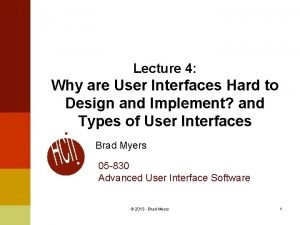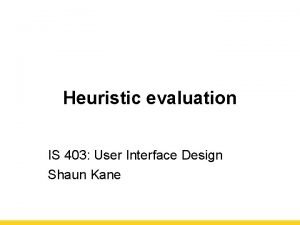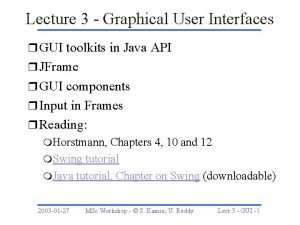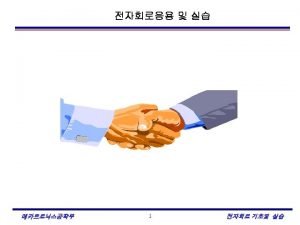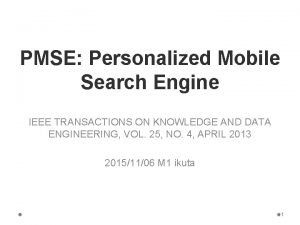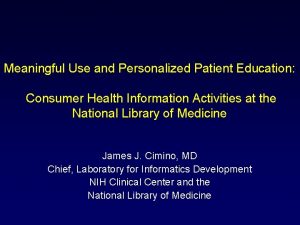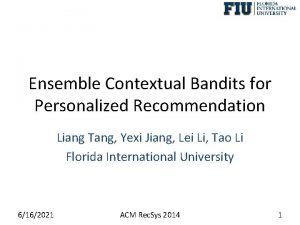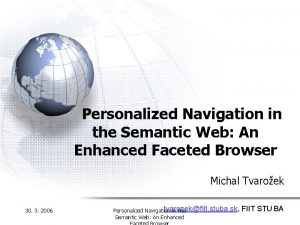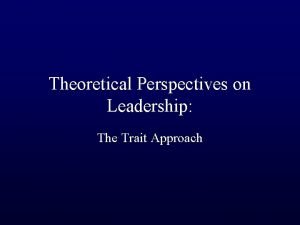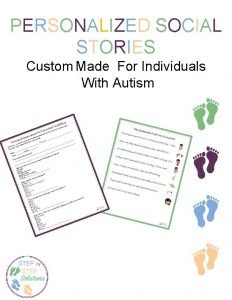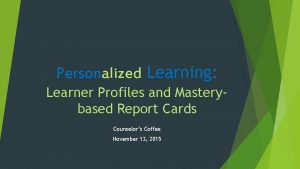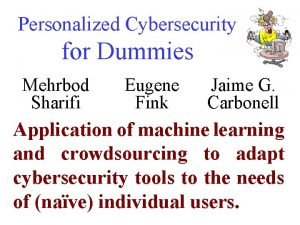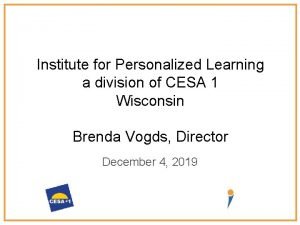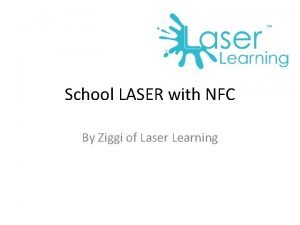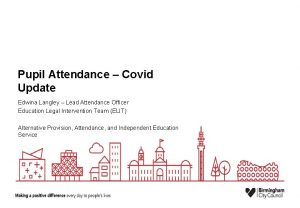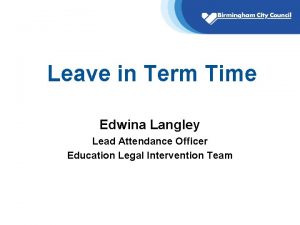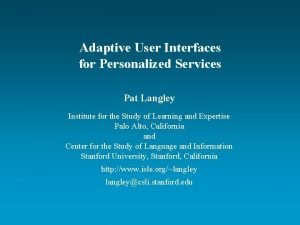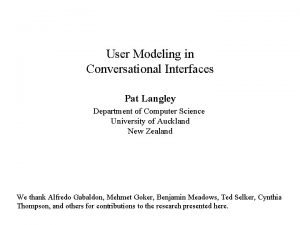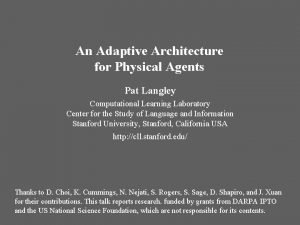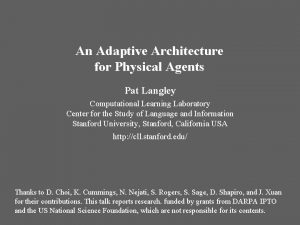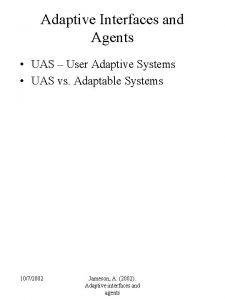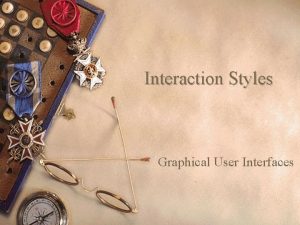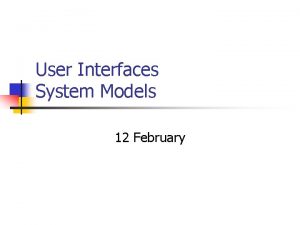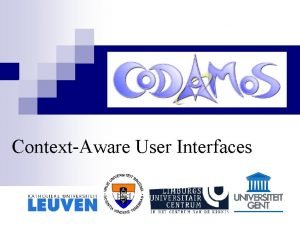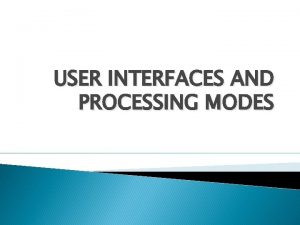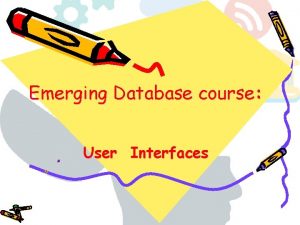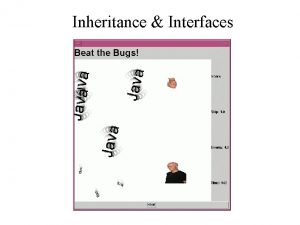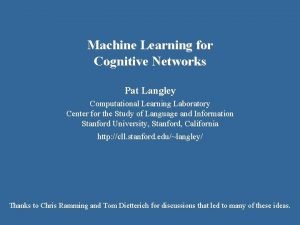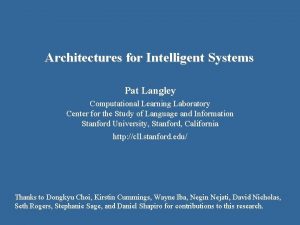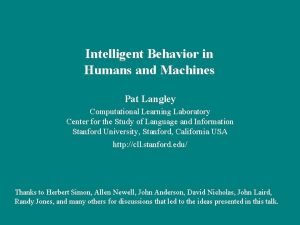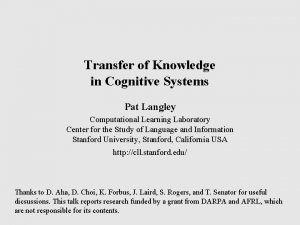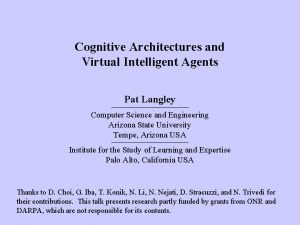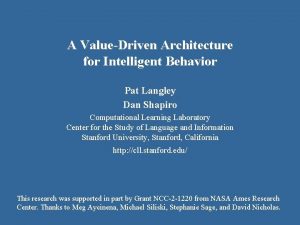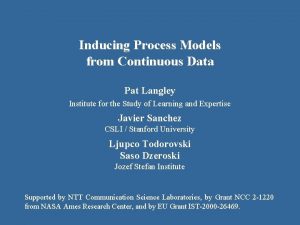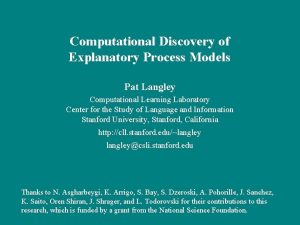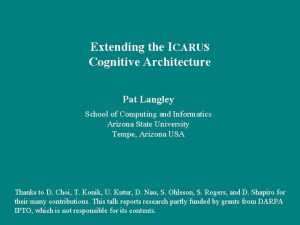Adaptive User Interfaces for Personalized Services Pat Langley
































- Slides: 32

Adaptive User Interfaces for Personalized Services Pat Langley Institute for the Study of Learning and Expertise Palo Alto, California and Center for the Study of Language and Information Stanford University, Stanford, California http: //cll. stanford. edu/~langley@csli. stanford. edu Thanks to D. Billsus, M. Chen, C. -N. Fiechter, M. Gervasio, M. Goker, W. Iba, S. Rogers, C. Thompson, and J. Yoo.

The Need for Personalized Assistance We now have more information and choices available than ever before, and we need help to handle them effectively. This has led to recommendation systems, which help users locate and select relevant items. But often we want personalized assistance that takes into account our individual preferences. However, such personalized response requires a user model or profile that is constructed in some manner.

Approaches to User Modeling Individual Profiles Stereotypical Profiles Manual Construction Hand-crafted Profiles Hand-crafted Stereotypes Automated Construction Adaptive User Interfaces Data-Mining Methods

Definition of an Adaptive User Interface a software artifact by acquiring a user model that reduces user effort based on past user interaction

Definition of a Machine Learning System a software artifact by acquiring knowledge that improves task performance based on partial task experience

Applications of Adaptive User Interfaces in-car navigation Web browsing interactive scheduling news filtering book selection stock tracking Email filing TV selection apartment selection

Inferring Individual User Profiles Tasks that require a user decision A description for each task Find Mapping from task features onto user decisions Traces of the user’s decisions Our work focuses on content-based approaches to adaptive user interfaces, rather than on collaborative approaches.

The Task of Route Selection One decision-making task that confronts drivers can be stated as: • Given: The driver’s current location C; • Given: The destination D that the driver desires; • Given: Knowledge about available roads (e. g. , a digital map); • Find: One or more desirable routes from C to D. Navigation aides already exist in both vehicles and on the World Wide Web. However, they do not give personalized navigation advice to individual drivers.

The Adaptive Route Advisor

Generating Training Cases The Adaptive Route Advisor represents the driver model as a weighted linear combination of route features. Time Distance Intersections Turns w 0 w 1 w 2 w 3 Cost Training cases: [x 0, . . . , xn] is better than [y 0, . . . , yn]. The system uses each training pair as constraints on the weights found during the modeling process.

Experimental Results on Route Advice Personalized user models produce better results than generalized models, even when the latter are based on more data.

The Task of News Reading Another service that would benefit drivers can be stated as: • Given: Topics and events that interest the driver; • Given: Recent news stories available on the Web; • Given: Knowledge about stories the driver has heard; • Find: Stories to read the driver during the current trip. Many online news services are available on the World Wide Web, but few offer personalized selection. Moreover, they are ill suited for use in the driving environment, where visual attention is a limited resource.

News Dude (Billsus & Pazzani, 1999)

Adaptive News Readers in the Marketplace

The Task of Destination Selection A third type of service that would assist drivers can be stated as: • Given: Some goal the driver wants to achieve (e. g. , eat lunch); • Given: Constraints on destinations that achieve this goal; • Given: Knowledge about available nearby destinations; • Find: One or more destinations that satisfy the constraints. Many recommendation systems are available on the World Wide Web, including ones that suggest restaurants. However, they are not designed for use by drivers, who must keep their eyes on the road.

The Adaptive Place Advisor

Adaptive Place Advisor (Before Adaptation) Inquirer: Where do you think I should eat tonight? Advisor: What type of food would you like? Inquirer: What types are there? Advisor: You can say things like Chinese, Indian, and Mediterranean. Inquirer: Oh, maybe a French place with free parking. Advisor: What quality rating would you like? Inquirer: I don't care, as long as it's cheap. Advisor: I’m sorry, I don’t know any restaurants like that. Would you like to search for any price? Inquirer: No, I think I'd like Chinese instead. Advisor: In what city would you like to eat? Inquirer: How about Berkeley? Advisor: How does the Long Life Vegi House on 2129 University Avenue sound? Inquirer: Sure, that sounds fine.

Adaptive Place Advisor (After Adaptation) Inquirer: Where do you think I should eat tonight? Advisor: What type of food would you like? Inquirer: Cheap Chinese. Advisor: What city do you prefer? Inquirer: How about Palo Alto? Advisor: How does Jing Szechuan Gourmet on 443 Emerson sound? Inquirer: Sure, that sounds fine.

Speech Acts Per Conversation with Adaptive Place Advisor

INCA: An Adaptive Scheduler

Back. Flip: Personalized Bookmarking

Personalized Music Delivery

A Personalized Travel Agent

An Adaptive Apartment Finder

An Adaptive Stock Tracker

Classification Ranked List Tweaked Set Sequential Alternative Presentation Styles

A Flexible Framework for Adaptive Interfaces initialize/ retrieve profile Long-term profile Item database initialize short-term profile Short-term profile modify Update profile suggest Suggestion present User query specify query Response respond Decision decide User

Challenges in Developing an Adaptive Interface Formulating the Problem Engineering the Representation Collecting User Traces Modeling Process Utilizing Model Effectively Gaining User Acceptance

Contributions of the Research Our research program on adaptive user interfaces has produced: • a variety of artifacts that learn user preferences unobtrusively; • evidence that this approach to user modeling is a general one; • experimental support for the effectiveness of these systems; • an analysis of presentation styles possible for such systems; • a flexible framework for constructing them efficiently; and • clarification of issues that arise in their effective design. Although some issues remain, we understand adaptive interfaces well enough to apply them in practical services.

Directions for Future Research Despite clear progress on adaptive user interfaces, we must still: • design methods to combine stereotypes and individual profiles; • create approaches that transfer user profiles across domains; • apply these techniques to an ever wider range of problems; • utilize new sensors to collect data even less obtrusively; and • develop complete physical environments that adapt to users. Together, these advances will lead us toward a society in which personalized computational aides are a regular part of our lives.


Dialogue Operators for Adaptive Place Advisor System Operators Ask-Constrain Ask-Relax Suggest-Values Suggest-Attributes Recommend-Item Clarify Asks a question to obtain a value for an attribute Asks a question to remove a value of an attribute Suggests a small set of possible values for an attribute Suggests a small set of unconstrained attributes Recommends an item that satisfies the current constraints Asks a clarifying question if uncertain about latest user operator User Operators Provide-Constrain Reject-Constrain Accept-Relax Reject-Relax Accept-Item Reject-Item Query-Attributes Query-Values Start-Over Quit Provides a value for an attribute Rejects the proposed attribute Accepts the removal of an attribute value Rejects the removal of an attribute value Accepts the proposed item Rejects the proposed item Asks system for information about possible attributes Asks system for information about possible attribute values Asks the system to re-initialize the search Asks the system to abort the search
 Pat pat seguimiento
Pat pat seguimiento![[web user interface] [web user interface]](data:image/svg+xml,%3Csvg%20xmlns=%22http://www.w3.org/2000/svg%22%20viewBox=%220%200%20200%20200%22%3E%3C/svg%3E) [web user interface]
[web user interface] Why are user interfaces hard to implement
Why are user interfaces hard to implement Design heuristic
Design heuristic Programming graphical user interfaces in r
Programming graphical user interfaces in r User interfaces design dc
User interfaces design dc Pat maths adaptive
Pat maths adaptive Sigir 2018
Sigir 2018 Personalized mobile search engine ieee paper
Personalized mobile search engine ieee paper Zaponet
Zaponet Personalized patient education
Personalized patient education Contextual bandits for personalized recommendation
Contextual bandits for personalized recommendation Dietmar jannach
Dietmar jannach Personalized navigation
Personalized navigation First draft personal statement
First draft personal statement Basic communication operations in parallel computing
Basic communication operations in parallel computing Limitations of trait theory of leadership
Limitations of trait theory of leadership Social stories questionnaire
Social stories questionnaire Personalized learning learner profile
Personalized learning learner profile Medicine
Medicine Personalized cybersecurity
Personalized cybersecurity Institute for personalized learning
Institute for personalized learning Single user and multiple user operating system
Single user and multiple user operating system Types of operating systems
Types of operating systems Lhpa laser login
Lhpa laser login Cardinal langley school holidays
Cardinal langley school holidays Cardinal langley holiday club
Cardinal langley holiday club Walter langley
Walter langley Edwina langley birmingham
Edwina langley birmingham Edwina langley birmingham
Edwina langley birmingham Edwina langley birmingham
Edwina langley birmingham Al langley nasa
Al langley nasa Nasa langley org chart
Nasa langley org chart
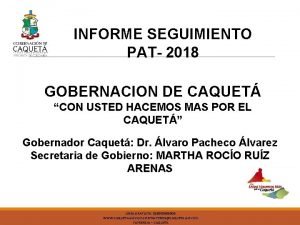
![[web user interface] [web user interface]](https://slidetodoc.com/wp-content/uploads/2020/12/3515569_e80293ca9d02734a3126f3e8d1d1c3b7-300x225.jpg)
